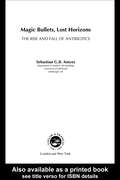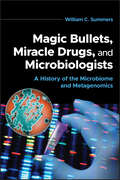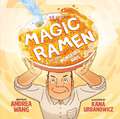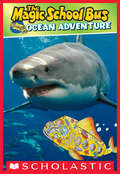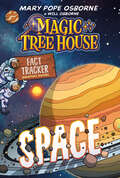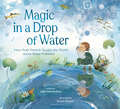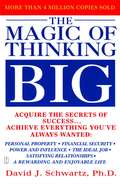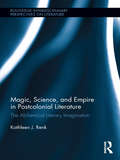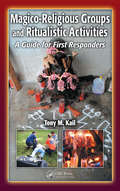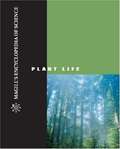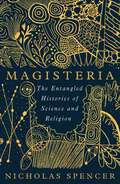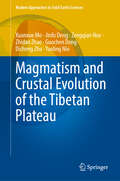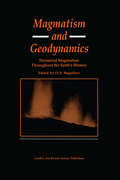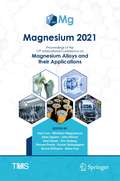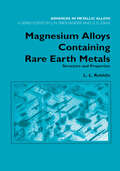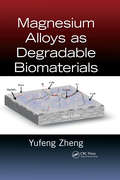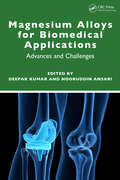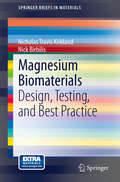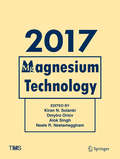- Table View
- List View
Magic Bullets, Lost Horizons: The Rise and Fall of Antibiotics
by Sebastian G. AmyesFrom the day that Paul Ehrlich hailed his newly discovered treatment for syphilis as the magic bullet, antibiotics have transformed medical practice. They are considered one of the miracle drugs of the 20th century. However, the massive and increasing misuse of these agents is More...causing a problem of resistance that may prove to be one of the greatest threats to health in the 21st century. Magic Bullets, Lost Horizons aims to put some of the media sensationalism into perspective. It examines not only the development of modern antibiotics but also the obstacles faced during application of the drugs and their expected efficacy in the future.
Magic Bullets, Miracle Drugs, and Microbiologists: A History of the Microbiome and Metagenomics
by William C. SummersMagic Bullets, Miracle Drugs, and Microbiologists Magic Bullets, Miracle Drugs, and Microbiologists: A History of the Microbiome and Metagenomics by William C. Summers is an enlightening journey through the fascinating world of microbiology, exploring its history, challenges, and the revolutionary concept of the microbiome. Summers draws from his unique perspective as both a practicing microbiologist and a historian of science, influenced by early microbiological literature and his own extensive career, presenting how our understanding of microbes evolved from concepts of simple germs to complex, essential elements of life. Summers skillfully ties together key players and eras in the microbial sciences into a concise narrative, from early microscopic observations to the revolutionary developments in genetic analysis and metagenomics, highlighting our ever-evolving understanding of the diverse microbial world. Magic Bullets, Miracle Drugs, and Microbiologists is a compelling read for anyone interested in the profound impact of microorganisms on our world. “Bill Summers artfully explains how, over the past century, scientists have synthesized new disciplines and embraced evolving technologies to develop new concepts about how germs behave in microbial communities and what their relationship is to the environment, human health, and epidemic diseases. Skillfully written in engaging prose, this book will be valuable to microbiologists, epidemiologists, medical historians, and geneticists seeking to better understand the historic roots of twenty-first century microbiology.” — Powel H Kazanjian, University of Michigan Medical School and Author of Frederick Novy and the Development of Bacteriology in Medicine
Magic Misoprostol: Reproductive Justice and Abortion Liberation in Latin America
by Cordelia FreemanAvailable open access digitally under CC-BY-NC-ND licence. How can a stomach ulcer drug transform abortion access? This book tells the story of misoprostol, a medication that was ‘discovered’ as a cheap and safe method for abortion in Latin America. This book develops three conceptual lenses: reproductive justice, mobility politics and geographies of knowledge, to explore the emergence and success of misoprostol for abortions. Chapters cover the experimentation process, activist groups, the challenges of moving the pill in clandestine contexts and how the pill interacts with the law. The book demonstrates how misoprostol, and the people who have mobilized it, have transformed abortion safety, knowledge and practices with global effects.
Magic Ramen: The Story of Momofuku Ando
by Andrea WangWorld War II was over, but in Japan, lines for a simple bowl of ramen noodles wound down the sidewalk. What Momofuku Ando did next would change food forever. Andrea Wang, author of Watercress (a Newberry honor book and winner of the Caldecott Medal), tells the true story behind the creation of one of the world's most popular foods."An inspiring story of persistence and an ideal purchase for any collection." School Library Journal, STARRED review2021 Nutmeg Book Awards NomineeWinner of the 2020 Sakura AwardRead Across America Book of the Month, May 2021Center for Multicultural Children's Literature Best Book of 2019 ListSmithsonian Magazine '10 Best Children's Books of 2019′ ListEvery day, Momofuku Ando would retire to his lab--a little shed in his backyard. For years, he'd dreamed about making a new kind of ramen noodle soup that was quick, convenient, and tasty for the hungry people he'd seen in line for a bowl on the black market following World War II. Peace follows from a full stomach, he believed.Day after day, Ando experimented. Night after night, he failed. But Ando kept experimenting.With persistence, creativity, and a little inspiration, Ando succeeded. This is the true story behind one of the world's most popular foods.
Magic School Bus: Ocean Adventure (Scholastic Reader, Level 2)
by Mary Kay CarsonNow early readers can take a ride on the Magic School Bus!With the help of Ms. Frizzle, young readers can develop their reading skills while they pick up fun facts about the world's ocean. Ms. Frizzle's class will teach you everything you ever wanted to know about the deep sea through this engaging and accesible reader. This is a great introduction to the Magic School Bus program.
Magic Tree House Fact Tracker #12: Sabertooths and the Ice Age
by Mary Pope Osborne Sal Murdocca Natalie Pope BoyceMagic Tree House Research Guides are now Magic Tree House Fact Trackers! Track the facts with Jack and Annie! When Jack and Annie got back from their adventure in Magic Tree House #7: Sunset of the Sabertooth, they had lots of questions. What was it like to live in the Ice Age? How did early humans stay warm enough to survive? Who made the first cave paintings? What happened to saber-toothed cats and woolly mammoths? Find out the answers to these questions and more as Jack and Annie track the facts. Filled with up-to-date information, photos, illustrations, and fun tidbits from Jack and Annie, the Magic Tree House Fact Trackers are the perfect way for kids to find out more about the topics they discovered in their favorite Magic Tree House adventures.
Magic Tree House Fact Tracker #18: Penguins and Antarctica
by Mary Pope Osborne Sal Murdocca Natalie Pope BoyceMagic Tree House Research Guides are now Magic Tree House Fact Trackers! Track the facts with Jack and Annie! When Jack and Annie got back from their adventure in Magic Tree House #40: Eve of the Emperor Penguin, they had lots of questions. What do penguins eat? Why do they huddle together in groups? Who won the race to the South Pole? What happens at a research station in Antarctica? Find out the answers to these questions and more as Jack and Annie track the facts. Filled with up-to-date information, photos, illustrations, and fun tidbits from Jack and Annie, the Magic Tree House Fact Trackers are the perfect way for kids to find out more about the topics they discovered in their favorite Magic Tree House adventures.
Magic Tree House Fact Tracker Graphic Novel: Space (Magic Tree House Fact Tracker Graphic Novels)
by Mary Pope OsborneWhen Jack and Annie got back from their adventure in Magic Tree House #8: Midnight on the Moon, they had lots of questions about planets, stars, and the universe. Learn more along with them as they track the facts about space—available for the first time ever in a nonfiction graphic novel format!Filled with up-to-date information and fun tidbits from Jack and Annie, the Magic Tree House Fact Tracker Graphic Novels are the perfect way for kids to find out more about the topics they discovered in their favorite Magic Tree House adventures!How did the universe begin? How long does it take to get to the moon? How hot is the sun? What does it feel like to be in space? There&’s so much to learn, so come along on an out-of-this-world adventure with Jack and Annie as they investigate and explore space—it&’s one readers ages 7-10 won&’t want to miss!Did you know that there&’s a Magic Tree House book for every kid?Magic Tree House: Adventures with Jack and Annie, perfect for readers who are just beginning chapter booksMerlin Missions: More challenging adventures for the experienced readerSuper Edition: A longer and more dangerous adventureFact Trackers: Nonfiction companions to your favorite Magic Tree House adventuresGraphic Novels: All the fun of the original Magic Tree House books, now available in an easy-to-read graphic format with all-new art!
Magic Tree House Incredible Fact Book: Our Favorite Facts about Animals, Nature, History, and More Cool Stuff! (Magic Tree House (R))
by Mary Pope Osborne Natalie Pope BoyceJack and Annie&’s biggest, most exciting book of facts is their greatest adventure outside the tree house! Jack and Annie have been all over the world in their adventures in the magic tree house. And they&’ve learned lots of incredible facts along the way. Now they want to share them with you! Get ready for a collection of the coolest, weirdest, funniest, grossest, most all-around amazing facts Jack and Annie have ever encountered. With full-color photographs and fun comments from Jack and Annie, this is the essential fact book for all Magic Tree House fans.
Magic in a Drop of Water: How Ruth Patrick Taught the World about Water Pollution
by Julie WinterbottomAn entertaining and gorgeous picture book biography of scientist and environmental hero Ruth Patrick, one of the first to warn about the dangers of pollution.A brilliant scientist and intrepid explorer, the ecologist Ruth Patrick taught the world how to care for the environment. She studied water pollution long before it became a public concern and gave other scientists the tools to do something about it. Born in 1907, Ruth Patrick was one of the only women in her field when she made her breakthrough discovery about biodiversity and the ecosystem of rivers, forever changing how ecologists understand pollution.Lyrically, joyfully written, exquisitely illustrated, and full of fascinating details and a rich afterword and timeline, this STEM biography will inspire readers who love the environment to follow their passion and curiosity.
Magic of Thinking Big
by David SchwartzMillions of people throughout the world have improved their lives using The Magic of Thinking Big. Dr. David J. Schwartz, long regarded as one of the foremost experts on motivation, will help you sell better, manage better, earn more money, and -- most important of all -- find greater happiness and peace of mind. The Magic of Thinking Big gives you useful methods, not empty promises. Dr. Schwartz presents a carefully designed program for getting the most out of your job, your marriage and family life, and your community. He proves that you don't need to be an intellectual or have innate talent to attain great success and satisfaction -- but you do need to learn and understand the habit of thinking and behaving in ways that will get you there. This book gives you those secrets!
Magic, Science, and Civilization
by Jacob BronowskiA compilation of a series of lectures detailing such varied topics as nature, magic and human civilization.
Magic, Science, and Empire in Postcolonial Literature: The Alchemical Literary Imagination (Routledge Interdisciplinary Perspectives on Literature)
by Kathleen RenkThis book examines the ways in which contemporary British and British postcolonial writers in the after-empire era draw connections between magic (defined here as Renaissance Hermetic philosophy) and science. Writers such as Tom Stoppard, Zadie Smith, and Margaret Atwood critique both imperial science, or science used in service to empire, and what Renk calls "imperical science," a distortion of rational science which denies that reality is holistic and claims that nature can and should be conquered. In warning of the dangers of imperical science, these writers restore the connection between magic and science as they examine major shifts in scientific thinking across the centuries. They reflect on the Copernican Revolution and the historic split between magic and science, scrutinize Darwinism, consider the relationship between Victorian science and pseudo-science, analyze twentieth-century Uncertainty theories, reject bio/genetic engineering, call for a new approach to science that reconnects science and art, and ultimately endeavor to bring an end to the imperial age. Overall, these writers forge a new discourse that merges science with the arts and emphasizes a holistic philosophy, a view shared by both Hermetic philosophy and recent scientific theories, such as chaos or complexity theory. Along with recent books that focus on the relationship between contemporary literature and science, this work focuses on contemporary British literature’s critique of science and the ways in which postcolonial literature addresses the relationship between magic, science, and empire.
Magico-Religious Groups and Ritualistic Activities: A Guide for First Responders
by Tony M. KailMore than just a litany of artifacts, rituals, and symbols, this valuable book provides a cultural bridge for emergency responders. It places the information in a relevant context and offers crucial keys to communication, assessment, and treatment in culturally sensitive situations. Beginning with the importance of trans-cultural communication, the book separates fact from fantasy regarding Neo-Paganism, Santeria, Bantu religion (Palo Mayombe), Voodoo, and Curanderismo. Promoting functional cultural competency, this book provides the tools to properly assess situations, open lines of communication, protect cultural diversity, and provide effective emergency treatment.
Magill's Encycopedia of Science: Plant Life Volume 1
by Bryan D. NessThis encyclopaedic reference provides information about the scientific principles, the classification, and the members of the plant kingdom.
Magisteria: The Entangled Histories of Science & Religion
by Nicholas SpencerMost things you &‘know&’ about science and religion are myths or half-truths that grew up in the last years of the nineteenth century and remain widespread today. The true history of science and religion is a human one. It&’s about the role of religion in inspiring, and strangling, science before the scientific revolution. It&’s about the sincere but eccentric faith and the quiet, creeping doubts of the most brilliant scientists in history – Galileo, Newton, Faraday, Darwin, Maxwell, Einstein. Above all it&’s about the question of what it means to be human and who gets to say – a question that is more urgent in the twenty-first century than ever before. From eighth-century Baghdad to the frontiers of AI today, via medieval Europe, nineteenth-century India and Soviet Russia, Magisteria sheds new light on this complex historical landscape. Rejecting the thesis that science and religion are inevitably at war, Nicholas Spencer illuminates a compelling and troubled relationship that has definitively shaped human history.
Magmatism and Crustal Evolution of the Tibetan Plateau (Modern Approaches in Solid Earth Sciences #25)
by Zengqian Hou Xuanxue Mo Jinfu Deng Zhidan Zhao Guochen Dong Dicheng Zhu Yaoling NiuThis book presents a comprehensive coverage of the magmatic and crustal evolution of the Tibetan Plateau through time, based mainly on the recent data and observations of the authors. It provides extensive geochemical, isotopic and geochronological datasets to better constrain the geodynamic evolution of the highest and thickest orogenic plateau in the world. It is a unique and original contribution to our understanding of the geology and landscape of the “roof of the world” in an integrated and multi-disciplinary approach. All chapters in the book are process-oriented and data-rich, and reflect the most recent knowledge and information on the Tibetan Plateau. All five authors of the book have worked extensively in Tibet and in the adjacent areas over the years. Their familiarity with both the geology of Tibet and all the research done there by different scientific teams during the last 30 years are a major driving force behind this book.
Magmatism and Geodynamics: Terrestrail Magmatism Throughout the Earth's History
by O. A. BogatikovMagnatism is the only true endogenic process for generating new material on the Earth's surface. Obviously, magmatism and tectonic movements are reflections of geodynamics, that is, physical processes which occur in deep-seated environments. What are the interrelationships between magmatism and tectronics? How did the character of terrestrial magmatism change through time and are there any irregularities in this process?
Magnaporthe oryzae: Methods and Protocols (Methods in Molecular Biology #2356)
by Stefan JacobThis volume highlights molecular methods to study the phytopathogenic rice blast fungus Magnaporthe oryzae. Chapters in this book cover the history, development, and evolution of the pathogen; molecular methods to increase the knowledge of the biology, genetic, and metabolic diversity of the pathogen; and the pathogen’s adaptability. Written in the highly successful Methods in Molecular Biology series format, chapters include introductions to their respective topics, lists of the necessary materials and reagents, step-by-step, readily reproducible laboratory protocols, and tips on troubleshooting and avoiding known pitfalls. Cutting-edge and comprehensive, Magnaporthe oryzae: Methods and Protocols is a valuable resource for any scientist or researcher interested in learning more about this developing field.
Magnesium 2021: Proceedings of the 12th International Conference on Magnesium Alloys and Their Applications (The Minerals, Metals & Materials Series)
by Bruce Williams John Allison Warren Poole Alan Luo Eric Nyberg Sean Agnew Mihriban Pekguleryuz Karl Kainer Kumar Sadayappan Steve YueThis collection from the 12th International Conference on Magnesium Alloys and Their Applications (Mg 2021)—the longest running conference dedicated to the development of magnesium alloys—covers the breadth of magnesium research and development, from primary production to applications to end-of-life management. Authors from academia, government, and industry discuss new developments in magnesium alloys and share valuable insights. Topics in this volume include but are not limited to the following: Primary production Alloy development Solidification and casting processes Forming and thermo-mechanical processing Other manufacturing process development (including joining and additive manufacturing) Corrosion and protection Modeling and simulation Structural, functional, biomedical, and energy applicationsAdvanced characterization and fundamental theoriesRecycling and environmental issues
Magnesium Alloys Containing Rare Earth Metals: Structure and Properties (Advances in Metallic Alloys)
by L.L. RokhlinMagnesium-based alloys containing rare-earth metals are important structural materials, as they combine low density with high-strength properties. This makes them particularly attractive for industry, especially in cases where the low weight of constructions is critical, as in aircraft and space apparatus construction. One of the remarkable feature
Magnesium Alloys as Degradable Biomaterials
by Yufeng ZhengMagnesium Alloys as Degradable Biomaterials provides a comprehensive review of the biomedical applications of biodegradable magnesium and its alloys. Magnesium has seen increasing use in orthopedic and cardiovascular applications over the last decade, particularly for coronary stents and bone implants.The book discusses the basic concepts of biodeg
Magnesium Alloys for Biomedical Applications: Advances and Challenges
by Deepak Kumar Nooruddin AnsariMagnesium alloys have enormous potential for use in biomedical implants. Magnesium Alloys for Biomedical Applications delves into recent advances and prospects for implementation and provides scientific insights into current issues posed by Mg alloy materials. It provides an overview of research on their mechanical and tribological characteristics, corrosion tendencies, and biological characteristics, with a particular emphasis on biomedical implants. Details the fundamentals of Mg alloys as well as necessary surface modifications of Mg alloys for biomedical use. Discusses emerging Mg alloys and their composites. Covers mechanical, tribological, and chemical properties, as well as fatigue and corrosion. Highlights emerging manufacturing methods and advancements in new alloy design, composite manufacturing, unique structure design, surface modification, and recyclability. Helps readers identify appropriate Mg-based materials for their applications and select optimal improvement methods. Summarizes current challenges and suggests a roadmap for future research. Aimed at researchers in materials and biomedical engineering, this book explores the many breakthroughs achieved with these materials and where the field should concentrate to ensure the development of safe and reliable Mg alloy-based implants.
Magnesium Biomaterials
by Nicholas Travis Kirkland Nick BirbilisMagnesium Biomaterials provides a succinct up-to-date overview of Magnesium biomaterial development, critically examines the types of in vitro experiments that may be performed, and investigates the numerous variables that affect Magnesium biodegradation when undertaking these experiments. This work also discusses the direction in which current Magnesium biomaterial development is heading and the necessary steps for future development of this field. Information is drawn from numerous multi-disciplinary sources to provide a coherent and critical overview. Magnesium Biomaterials is ideal for researchers in the area of bio-Mg, companies interested in exploring their own alloys, and for researchers working with other biodegradable materials who are seeking a cross-platform understanding of material performance.
Magnesium Technology 2017
by Alok Singh Neale R. Neelameggham Kiran N. Solanki Dmytro OrlovThe Magnesium Technology Symposium, the event on which this collection is based, is one of the largest yearly gatherings of magnesium specialists in the world. Papers represent all aspects of the field, ranging from primary production to applications to recycling. Moreover, papers explore everything from basic research findings to industrialization. Magnesium Technology 2017 covers a broad spectrum of current topics, including alloys and their properties; cast products and processing; wrought products and processing; forming, joining, and machining; corrosion and surface finishing; ecology; and structural applications. In addition, there is coverage of new and emerging applications.
